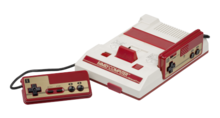
Back NES AN نينتندو إنترتينمنت سيستم Arabic نينتيندو انترتينيمنت سيستم ARZ Nintendo Entertainment System AST Nintendo Entertainment System Byelorussian Nintendo Entertainment System Breton Nintendo Entertainment System BS Nintendo Entertainment System Catalan سیستمی چێژبەخشی نینتێندۆ CKB Nintendo Entertainment System Czech
This article or section is in a state of significant expansion or restructuring. You are welcome to assist in its construction by editing it as well. If this article or section has not been edited in several days, please remove this template. If you are the editor who added this template and you are actively editing, please be sure to replace this template with {{in use}} during the active editing session. Click on the link for template parameters to use.
This article was last edited by [[User:|]] ([[User talk:|talk]] | contribs) 0 seconds ago. (Update timer) |
 | |
Top: NES Control Deck (with detachable controllers) Bottom: Family Computer ("Famicom") main unit (with hardwired controllers) | |
| Also known as | Family Computer/Famicom (Japan) Hyundai Comboy (South Korea) Samurai Electronic TV Game System (India) Dendy (Post-Soviet countries) Nintendo Entertainment System (PAL A/PAL B/Southeast Asia) |
|---|---|
| Developer | Nintendo R&D2 |
| Manufacturer | Nintendo |
| Type | Home video game console |
| Generation | Third |
| Release date | |
| Lifespan | 1983-1993 (20 years) |
| Introductory price | ¥14,800 (equivalent to ¥18,365 in 2019) US$179 (equivalent to $510 in 2023)[4] |
| Discontinued | |
| Units sold | 61.91 million[6] |
| Media | Nintendo Entertainment System Game Pak |
| CPU |
|
| Display | 256 × 240 px |
| Graphics | PPU (Ricoh 2C02) |
| Sound | APU, 5 channels: 2 pulse wave, triangle wave, white noise, DPCM |
| Controller input | 2 controller ports[d] 1 expansion slot |
| Best-selling game |
|
| Predecessor | Color TV-Game |
| Successor | Super NES |
| Related | Famicom Disk System, Famicom 3D System |
The Nintendo Entertainment System (NES) is an 8-bit home video game console produced by Nintendo. It was first released in Japan on 15 July 1983 as the Family Computer (Famicom).[note 1] It was then released in American test markets on 18 October 1985 as the redesigned NES, and fully launched in the United States the following year. The NES was distributed in Europe, Australia, and parts of Asia throughout the 1980s under various names. As a third generation console, it primarily competed with Sega's Master System and the Atari 2600.
It was designed by Masayuki Uemura at the behest of Nintendo's president Hiroshi Yamauchi, who called for a simple, cheap console that could run arcade games on cartridges. The controller design was reused from Nintendo's portable Game & Watch hardware. Nintendo released several add-ons, such as the NES Zapper light gun for shooting games like Duck Hunt.
The NES is regarded as one of the most influential consoles of all time. It helped revitalise the American gaming industry following the video game crash of 1983,[e] and pioneered a now-standard business model of licensing third-party developers to produce and distribute games.[10] The NES features several groundbreaking games, such as the 1985 platform game Super Mario Bros. and the 1986 action-adventure games The Legend of Zelda and Metroid, which became long-running franchises. While the NES dominated Japanese and American markets, it saw less success in Europe, where microcomputers were prevelant. With 61.91 million units sold, the NES remains one of the best-selling consoles of all time. It was succeeded in 1990 by the Super Nintendo Entertainment System. In 2011, IGN named the NES the greatest video game console of all time.[11]
- ^ Kohler, Chris (October 18, 2010). "Oct. 18, 1985: Nintendo Entertainment System Launches". WIRED. Archived from the original on November 26, 2020. Retrieved June 11, 2015.
- ^ https://www.youtube.com/watch?v=MwPXJOs0ixg Archived June 26, 2023, at the Wayback Machine 7:48
- ^ "Video Games Around the World: South Africa". Archived from the original on September 25, 2022. Retrieved September 25, 2022.
- ^ Levin, Martin (November 20, 1985). "New components add some Zap to video games". San Bernardino County Sun. p. A-4.
- ^ "Nintendo Entertainment System (NES) – 1985–1995". Classic Gaming. GameSpy. Archived from the original on October 29, 2012. Retrieved December 20, 2019.
- ^ a b "Consolidated Sales Transition by Region" (PDF). Nintendo. March 2016. Archived (PDF) from the original on April 27, 2016. Retrieved September 12, 2022.
- ^ Stuart, Keith (September 13, 2010). "Super Mario Bros: 25 Mario facts for the 25th anniversary". The Guardian. Archived from the original on August 9, 2017. Retrieved November 2, 2018.
- ^ Goss, Patrick. "The games that sold consoles". MSN. Archived from the original on March 9, 2008. Retrieved September 24, 2011.
- ^ a b Cite error: The named reference
Game Overwas invoked but never defined (see the help page). - ^ Sanchez-Crespo, Daniel (September 8, 2003). Core Techniques and Algorithms in Game Programming. New Riders Games. p. 14. ISBN 0-13-102009-9.
- ^ "Nintendo Entertainment System (NES) is number 1 – IGN". IGN. 2011. Archived from the original on July 10, 2022. Retrieved July 10, 2022.
Cite error: There are <ref group=lower-alpha> tags or {{efn}} templates on this page, but the references will not show without a {{reflist|group=lower-alpha}} template or {{notelist}} template (see the help page).
Cite error: There are <ref group=note> tags on this page, but the references will not show without a {{reflist|group=note}} template (see the help page).
© MMXXIII Rich X Search. We shall prevail. All rights reserved. Rich X Search

